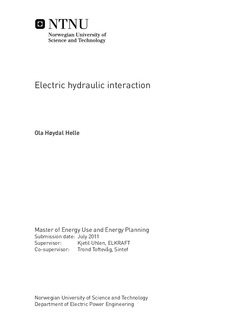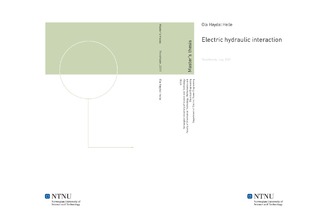| dc.contributor.advisor | Uhlen, Kjetil | nb_NO |
| dc.contributor.advisor | Toftevåg, Trond | nb_NO |
| dc.contributor.author | Helle, Ola Høydal | nb_NO |
| dc.date.accessioned | 2014-12-19T13:52:51Z | |
| dc.date.available | 2014-12-19T13:52:51Z | |
| dc.date.created | 2011-10-05 | nb_NO |
| dc.date.issued | 2011 | nb_NO |
| dc.identifier | 445816 | nb_NO |
| dc.identifier | ntnudaim:6268 | nb_NO |
| dc.identifier.uri | http://hdl.handle.net/11250/257127 | |
| dc.description.abstract | The hydraulic models representing hydro turbines and conduit system found instandard model libraries of power system analysis tools are often simplied mod-els. Subsequently, important information about the dynamics of the hydraulicsystem may not be properly represented by such models, putatively resultingin insucient representation of the interaction between the electric system andhydraulic system.In this master thesis three dierent hydraulic models for hydro power plantsequipped with Francis turbines for use in power system simulation software hasbeen studied: 1) a simplied model often found in power system simulation tools;2) a model including a surge tank and elastic water column and 3) a model thatincludes a surge tank, elastic water column and turbine parameters accountingfor the characteristics of the hydraulic turbine.The hydraulic models were implemented in Simpow, a power system simulationtool. A frequency scan in the range from 103-5 Hz was performed. The re-sults were compared with a frequency scan from LVtrans, a program specicallydesigned for accurate simulation of the dynamics of the hydraulic side in hydropower plants. The comparison showed that the simplied model failed to prop-erly represent the dynamics of the conduit system. The the model with surgetank and elastic water column was able to represent the dynamics of the con-duit system with satisfactory accuracy. Best representation was achieved for themodel including turbine parameters.The three hydraulic models were implemented in three dierent power systemcongurations: a single machine innite bus system; a system consisting of twointerconnected areas; and a system that has sustained power oscillations. Theresulting active power delivered from the generator were the hydraulic modelswas implemented, the speed of the turbine, the pressure at turbine and the owthrough the turbine were investigated.The simulation results revealed that the active power variation from the gener-iiators is in the same range for all three models, except for the simulation withsustained power oscillations. The speed variations of the turbine as a result ofincidents in the electrical network are in the same range for all three models.The model including turbine parameters is the only model able to representthe pressure variation as a result of a variation of speed of the turbine. Forpower oscillations with frequencies equal to the half period frequency of the waterhammer eect,1.38Hz, both the model with surge tank and elastic water columnand the turbine parameter model show very little response. For frequencies equalto the water hammer eect, 0.69Hz the variation in ow is also small for the twomodels. In general, the model with turbine parameters are better damped thanthe two other models.Further work should include development of an automated routine for determin-ing parameters to use in the model with turbine parameters as well as investiga-tions of how the model behaves in dierent network congurations. | nb_NO |
| dc.language | eng | nb_NO |
| dc.publisher | Institutt for elkraftteknikk | nb_NO |
| dc.subject | ntnudaim:6268 | no_NO |
| dc.subject | MTENERG energi og miljø | no_NO |
| dc.subject | Energibruk og energiplanlegging | no_NO |
| dc.title | Electric hydraulic interaction | nb_NO |
| dc.type | Master thesis | nb_NO |
| dc.source.pagenumber | 69 | nb_NO |
| dc.contributor.department | Norges teknisk-naturvitenskapelige universitet, Fakultet for informasjonsteknologi, matematikk og elektroteknikk, Institutt for elkraftteknikk | nb_NO |

